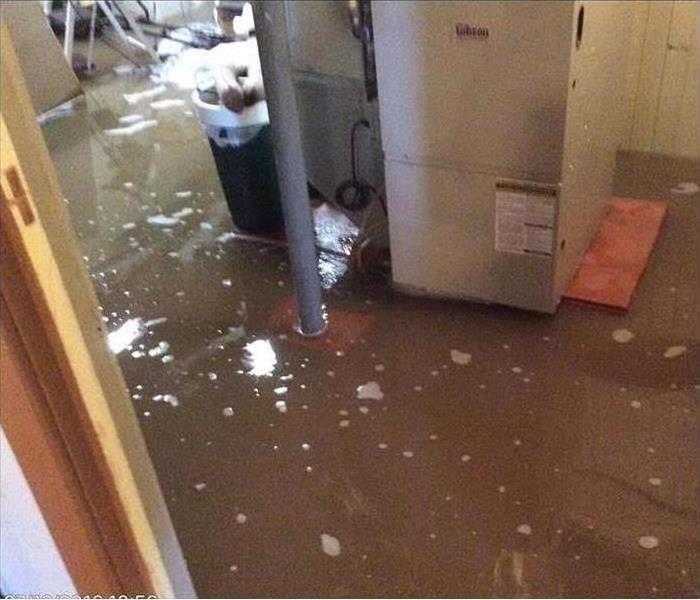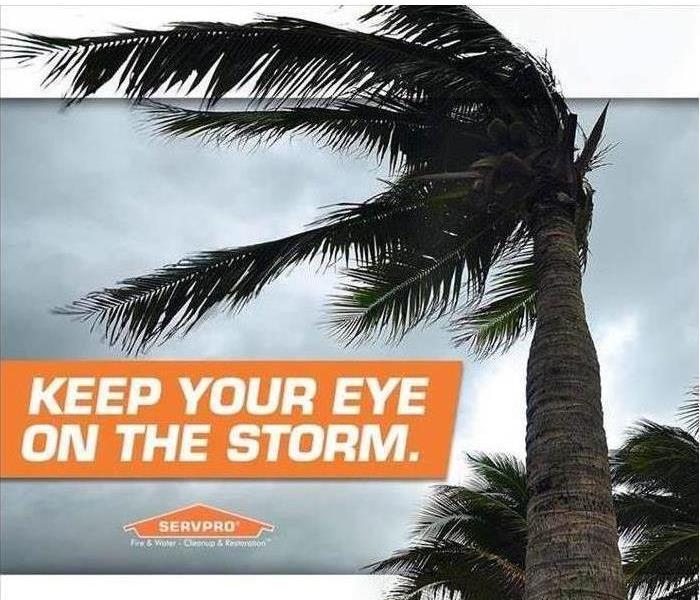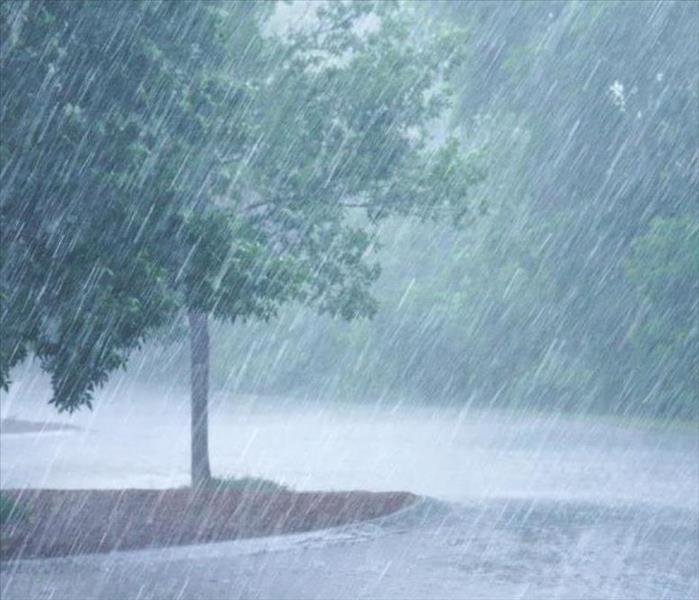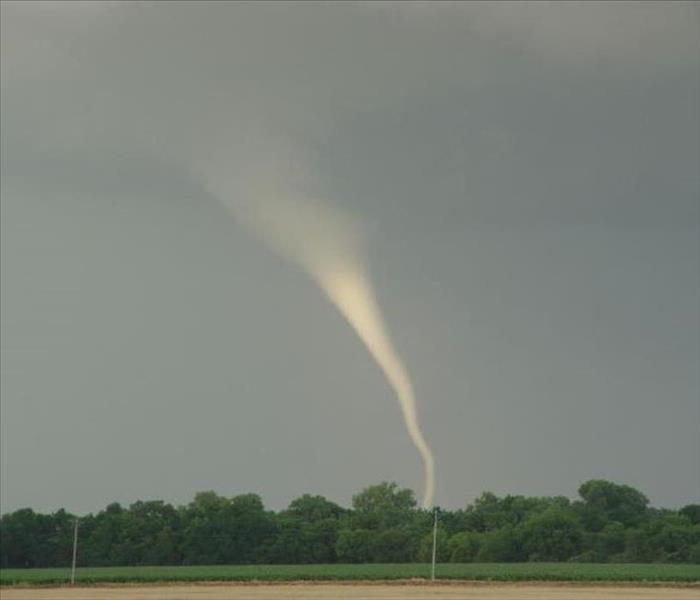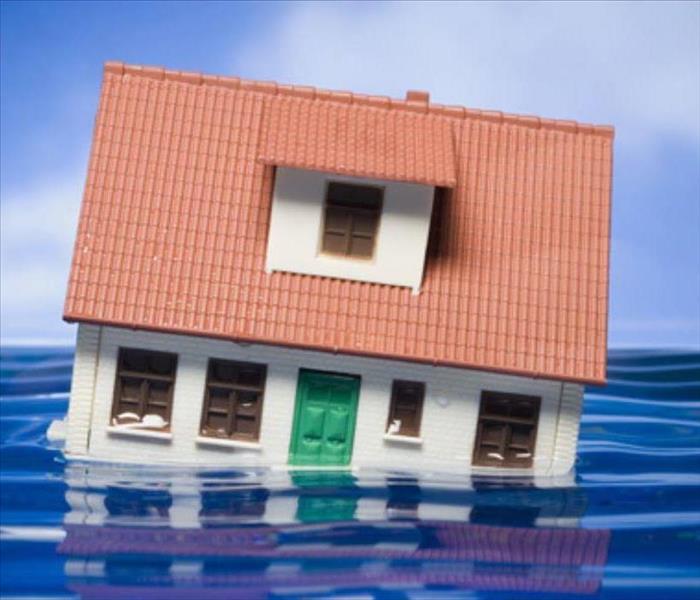Recent Storm Damage Posts
The Storm Damage Restoration Process: What To Expect
4/1/2022 (Permalink)
If a storm damaged your home , you might be worried about the storm restoration process. You may wonder how anyone can fix all that water damage or what happens if they must tear out a wall.
It’s understandable that you would worry about this. After all, restoration can seem daunting to the uninitiated. Luckily, understanding the steps can help calm your nerves. While all projects are unique, these are the basic steps to expect:
- Initial damage control
- Removal of damaged materials
- A drying period
- Rebuilding
Each of these steps is important and should be done by experienced and trusted professionals. Below is a closer look at each stage:
Initial Damage Control
Before your restoration crew can do anything else, they must extract the water from your home. This is the first step in stopping further water damage and keeping needed repairs to a minimum. It’s essential to call a storm restoration company as soon as possible after a flood to get this process going.
Removal of Damaged Materials
Once the water is out of the way, the contractors can survey the damage and decide what they need to tear out. They may decide to make a flood cut, which prevents mold by removing a section of wall above the flood line. The professionals will properly dispose of damaged materials to keep your home safe.
A Drying Period
The third step can be the most difficult for anxious homeowners. The affected area must be allowed to dry out, which can take some time. Be patient; you’re almost done.
Rebuilding
After the area is dry, the professionals can start rebuilding the damaged structures. Great companies can make sure it looks as good as or better than before.
If a flood damages your home, call a trusted storm restoration company immediately. They can get rid of the water, tear out damaged walls, and make it look like water damage never happened. 864-229-6610
What to do before a thunderstorm!
3/22/2022 (Permalink)
Thunderstorms can be dangerous and not taken for granted. Every thunderstorm produces lightning and other hazardous weather conditions, which can include tornadoes, strong winds, hail, and flash flooding.
In our area we tend to get a mix of heavy rain and dry thunderstorms. Below are great tips from the READY to help prepare you for what to do before, during, and after a thunderstorm.
What to do before a thunderstorm
- To begin preparing, you should build an emergency kit and make a family communications plan.
- Remove dead or rotting trees and branches that could fall and cause injury or damage during a severe thunderstorm.
- Postpone outdoor activities.
- Secure outdoor objects that could blow away or cause damage.
- Get inside a home, building, or hard-top automobile (not a convertible). Although you may be injured if lightning strikes your car, you are much safer inside a vehicle than outside.
- Remember, rubber-soled shoes and rubber tires provide NO protection from lightning. However, the steel frame of a hard-topped vehicle provides increased protection if you are not touching metal.
- Shutter windows and secure outside doors. If shutters are not available, close window blinds, shades, or curtains.
- Unplug any electronic equipment well before the storm arrives.
- Lightning Risk Reduction When Outdoors
SERVPRO of Greenwood urges each and every one of you to PREPARE before a thunderstorm comes. And whenever they do come, SERVPRO of Greenwood will be here to help. 864-229-6610
Spring Weather Brings a Variety of Hazards and Storms
3/22/2022 (Permalink)
The United States is a big territory, and having such a big space under one umbrella means that the spring season looks different depending on where you go. We are second in size only to Russia and Canada, although China is larger if you don’t count all the United States outlying territories.
Our vast space means that no two weather patterns will be the same. As spring nears and cold air begins to collide with warm air, let’s take a look at what different geographical regions can expect, and specifically, what we can expect here in Greenwood, Abbeville & McCormick County.
The Upper Midwest and Northeast regions don’t always get to experience a warmup in the spring. This area stays colder than any other throughout the season as winter often doesn’t lose its grip until early summer. Residents from Maine to the Dakotas can expect extreme cold and the possibility of snowstorms and blizzards.
Those in the Pacific Northwest region are prone to heavy rain over the spring months, which can cause flooding and water damage issues. Higher elevations often are still dealing with snow like their northeast neighbors, and the melting and runoff from that can cause even more problems for residents in this area.
The flip side of these two areas, the southern West Coast, has to prepare for extreme heat that can create a dangerous situation for safety and quality of life. There is also the threat of tsunamis in areas of the South Pacific, including Hawaii, caused by shifts in the tectonic plates.
Here in the Southeast, we can expect severe storms and tornadoes as our weather experiences extreme shifts in temperature. Coastal states near us also have to contend with rip currents and early season hurricanes as spring takes hold.
The true tornado alley, the middle region of the country likely understands the risk of tornadoes better than we do. From Iowa to down to Texas contends with windstorms, derechos and fire risks made especially dangerous by dry conditions and swinging temperatures.
No matter where you live, you will experience some form of extreme weather as we move out of winter and towards summer. We know well here in South Carolina that staying prepared pays, no matter what spring may bring.
Flood Damage Emergency Tips
3/21/2022 (Permalink)
After any flooding situation, your primary focus should be safety first:
- Is it safe to stay in the house?
- Electrical and "slip and fall" hazards are some of the most prevalent concerns.
- Only do activities that are safe for you to perform.
- Wet materials can be VERY heavy. Be careful!
If you experience water damage to your home after a flood, here are some tips that you can do until the SERVPRO of Greenwood, Abbeville & McCormick Co. team arrives on site:
- Remove excess water by mopping and blotting.
- Wipe excess water from wood furniture after removal of lamps and tabletop items.
- Remove and prop wet upholstery and cushions.
- Place aluminum foil or wood blocks between furniture legs and wet carpeting.
- Turn the air conditioning on for maximum drying in summer.
- Remove colored rugs from wet carpeting.
- Remove art objects to a safe, dry place.
- Gather loose items from floors.
We are storm damage specialists. If you have water damage in your home after a flood, call us at 864-229-6610. SERVPRO can get your property back to pre-flood condition.
Choose SERVPRO to Handle Your Flood Damage
3/21/2022 (Permalink)
Dealing with flood water can be a time-consuming mess. While total prevention may not be possible, being prepared can minimize damage.
Indiana is known for its constant changes in weather, making our homes an easy target for storm damage. That’s why our team at SERVPRO of Greenwood, Abbeville & McCormick Counties are ready to help 24/7. Whether your home or business is affected by flood damage, your property needs specialized equipment and techniques to restore it back to its pre-damaged condition.
Our technicians have been specially trained to handle these sorts of unique situations to help get your life back to normal as soon as possible. Storm damage can include not only water damage but mold damage, too. It may seem like a daunting challenge to overcome, but SERVPRO has the resources and tools to restore your property and make it “Like it never even happened.”
What to Do When Unexpected Storm Damage Comes Your Way
3/16/2022 (Permalink)
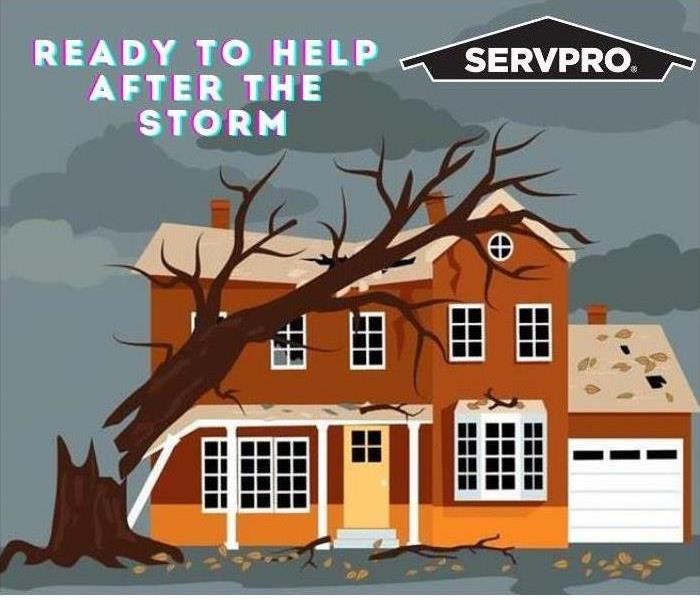 “Do you have storm damage to your home?
“Do you have storm damage to your home?
Technology has come such a long way in recent decades, but nothing is perfect. Raging storms will take you by surprise more often than you would like to admit. Regardless of the notice you may or may not receive, the real question is how prepared you are.
Are You Ready for The Unexpected?
Are your outside structures sound? Is your lawn furniture secure? Is your home surrounded by mature trees? These things and more play an essential part in how significant your damage could be. High wind speeds can send a tree or large tree limb crashing down, taking your car, roof, or the walls of your home with it. Not only does this cause tremendous structural damage, but the gaping hole allows rainwater to freely flow into your home. All of this can happen in a split second, causing irreparable damage to floors, walls, furniture, and family treasures.
You never know if or when this will happen to you, so it is best to have a plan. There is not much you can do physically to prevent further damage when there is a huge tree in your hallway. However, there are things you can take to lessen the likelihood of damage. Here are a few steps that will better ensure your safety and facilitate a quick restoration process.
Maintain Your Surroundings
Clear any surrounding trees or large items that can potentially damage your home or vehicle. Trees should generally be 10 to 20 feet from your house, but this may change depending on the tree type and size. Secure any loose items that could blow into your home. This includes lawn furniture, grills, yard tools, and toys.
Evacuate Once Damage Has Occurred
Should storm damage occur to your home, get yourself and your family out of the house immediately. It is possible for a storm to cause downed power lines, gas leaks, or an instable home foundation. It is imperative to wait for the home to be inspected for safety hazards prior to reentering your home.
Taking the Next Steps
Once you are safe, survey the damage and take pictures. Document everything for insurance purposes. Make sure you notify emergency services, if needed. Then call your insurance representative. Your insurance company will walk you through your coverage plan and discuss options. Lastly, don’t forget to contact SERVPRO of Greenwood, Abbeville & McCormick for your water damage and fire restoration needs. Our technicians will schedule a time to arrive onsite and identify how much damage has been caused and create a restoration plan. We will also work directly with your insurance company so you can focus on other matters.
Do not attempt to tarp the roof, replace windows, or clean water near the affected site by yourself. Repairing something yourself could unintentionally cause further damage to the home, or injuries to yourself.
If your home sustains water or fire damage due to a storm, you can count on us to help. We are available 24/7 to assist your family in your time of need. Call SERVPRO of Greenwood, Abbeville & McCormick Co. at 864-229-6610 for all your storm restoration needs.
2022 Storm Damage
3/1/2022 (Permalink)
SERVPRO of Greenwood, Abbeville & McCormick County specializes in storm and flood damage restoration. Storms can cause a lot more damage to your home than just flooding. Our crews are highly trained, and we use specialized equipment to restore your property to its pre-storm condition.
Faster Response
Since we are locally owned and operated, we are able to respond quicker with the right resources, which is extremely important. A fast response lessens the damage, limits further damage, and reduces the restoration cost.
Resources to Handle Floods and Storms
When storms hit, we can scale our resources to handle a large storm or flooding disaster. We can access equipment and personnel from a network of over 1,650 Franchises across the country and elite Disaster Recovery Teams that are strategically located throughout the United States.
Have Storm or Flood Damage? Call Us Today 864-229-6610. We want to help you get your home back to normal in no time!
Storm Damages: Flood Edition-Be Prepared
4/2/2021 (Permalink)
SERVPRO of Greenwood County is always here to help and we want you to ALWAYS be prepared. Here are some tips from FEMA(Federal Emergency Management Agency) for preparing your home or business for a flood.
Before the Flood:
- Have a qualified professional elevate the furnace, water heater and electric panel if susceptible to flooding.
- Install “check valves” in sewer traps to prevent flood water from backing up into the drains of your home or business.
- Seal walls in basements with waterproofing compounds to help avoid seepage.
During the Flood:
- Turn off utilities at the main switches or valves if instructed to do so.
- Disconnect electrical appliances .
- Do not touch electrical equipment if you are wet or standing in water.
- Do not walk through moving water. Even six inches of moving water can make you fall.
After the Flood:
- Listen for news reports to learn if the community’s water supply is safe to drink.
- Avoid floodwaters. Water may be contaminated by oil, gasoline or raw sewage. Water may also be electrically charged.
- Stay out of any building if it is surrounded by floodwaters.
- Return home only when authorities indicate it is safe to do so.
Rainy Days Carpet Pains
3/19/2021 (Permalink)
April Showers are coming, and we know what that means…. muddy yards! If you have little ones or pets you know all too well the fear that comes from the sight or puddles forming in your yard. The carpet and flooring that you’ve spent your quarantine time deep cleaning, is now lacking its luster.
Fear not! We’ve put together a simple solution for removing those pesky mud stains, and it’s much simpler than you’d think! Don’t run to the store for a specialty product or “miracle” stain remover, everything you need is probably already in your cabinets.
You’re probably tempted to start cleaning that mud the moment you spot it, but, practice some patience and allow the spot to dry completely before you touch it. After it has dried, you’ll want to vacuum the area to remove all loose dirt. Next, you’ll want to spray the spot with a mixture of 50% water and 50% white vinegar (keep this handy as it’s a wonderful all-purpose cleaner). Using a white cloth or towel begin to blot up the 50/50 mixture you’ve sprayed on. Continue until all signs of the stain have disappeared.
We don’t recommend following the instructions given by popular blogs and DIY sources that suggest the use of mild dish soap or detergent. While they do clean effectively, if they are not thoroughly rinsed afterwards, a sticky residue is left behind. This residue may be difficult to feel, and attracts dirt particles like a magnet. The clean spot you once had will be quickly discolored.
Having trouble with a stain? Call our office, our Certified Carpet Cleaning Technicians have the tools and know-how to restore your carpets!
How to prepare for a Storm
3/19/2021 (Permalink)
Here in the Upstate we can count on having unpredictable weather, from a warm sunny day in December to tornadoes in March. But when disaster strikes SERVPRO is here for you! We are only a phone call away to help you pick up the pieces, however, you might want to know how to prepare for the worst while you hope for the best. We can help with that, too!
- Make sure your gutters are cleaned out. Gutters full of leaves and debris can contribute to water leaking into your home or business.
- Inspect your roof; checking for loose or missing shingles can also prevent moisture from getting into your property.
- Check the trees near your home or business to ensure none are too weak to stand up to storm winds and therefore will not fall onto and structures.
- Be prepared in case of loss of power
- Get a generator to maintain power to your major appliances or for your furnace
- Place a thermometer in your refrigerator and freezer, perishable foods need to maintain a temperature below 40 degree.
We hope this guide will serve you well, but SERVPRO will have a team standing by 24/7 for any cleaning or restoration needs! Call us at 864-229-6610!
Storms & Flooding
3/19/2021 (Permalink)
We all get that panic feeling when we see those awful words come across our phones "Flash Flood Waring". There are some things you can do to be better prepared in your home to protect it and your belongings.
- Move important items to higher areas-counters or tables
- Make sure all doorways are clear of debris inside and out
- Do a quick clean out of your gutters and down spouts
- Make sure all windows and door are closed tight
- Bring outside furniture in
Find and save our number. When disaster strikes we're ready for anything. 24/7.
After the Storm
3/19/2021 (Permalink)
We're all prepared and ready for when a storm comes. But what about after the storm? Do you have a checklist of what to look for? Storms and the after effects they leave behind can be stressful. Don't get overwhelmed.
Once you know it's safe to enter your home begin taking pictures of the after damage, before you move anything.
Before you enter the home step back and try to see as much of the roof as possible. Are there missing shingles? Are there any visible holes? Before you enter the home make sure all doorways are clear and secure.
Once inside your home check to make sure that there are no cracks or visible leaks.
Once you have done your own initial walk through call us. The faster the call comes in the faster we can remove any water and begin the restoration process.
Never try to do the clean up alone. Water damage can look dry but damage can be below the surface.
CALL US TODAY!
864-229-6610
With Hurricane Season Approaching in a Couple of Months it's Better to be Prepared
3/17/2021 (Permalink)
Studying Hurricane Categories for Disaster Restoration Response
When a community is impacted by a hurricane, SERVPRO is quick to respond. Our company has access to over 1,700 franchises nationwide, and our storm response teams have decades of experience.
Hurricane Categories
Category 1 Hurricane
Dangerous winds are associated with Cat 1 hurricanes. During these storms, we expect to see damage to a home’s roof, gutters, and vinyl siding. We also expect to see some tree damage, especially branches falling atop of unshielded vehicles or falling onto homes. In this case, our franchise prepares expects to see some water damage and a large need for roof tarping.
Category 2 Hurricane
The winds in a Cat 2 hurricane are around 100 mph and will cause more damage than a Category 1 Hurricane. Even well-constructed homes have a large possibility of getting major damage to its roof and siding. We also expect to see trees uprooted and block roadways. Power outages are also extremely common. In this scenario, our franchise will take a large load of roof tarping materials and power tools to assist with debris removal for roadways that are blocked on the ways to homes in need. We also expect the need for our own power generators.
Category 3 Hurricane
A category 3 hurricane is considered to be a major hurricane. In a Cat 3 hurricane scenario, we expect to see major damage or even the removal of the roof decking. We also expect to see trees and branches uprooted and either block roadways or damage homes themselves as they fall. Electricity and water outage will likely be a factor. In this case, our franchise responds similarly as we do to Cat 2 hurricanes, which is by taking roof tarping materials, power tools to clear debris, and carrying our own generators. Due to the amount of fallen water associated with this category of hurricane, we also expect to not have immediate access to flooded areas of the community. If this is the case, we will wait for approval from first responders before proceeding.
Category 4 Hurricane
In a Cat 4 hurricane, we expect to see homes lose some or all of their roof and have damage to their exterior walls. Many trees, even those deeply rooted, will be snapped and often fall onto homes, vehicles, and block roadways. It’s not uncommon to see many homes cut off from emergency services due to debris. With the loss of electrical power and water plus the flooding and blocked roadways, the areas impacted with a category 4 hurricane may not be accessed for days or even weeks. In this scenarios, our crews are first helping the outer areas and assisting homes that are accessible as we wait for first responders to reach these areas and deem them accessible. Due to the time it takes the water to recede, our franchise expects major damage to homes and businesses. Flooring and a major portion of the walls in these properties will need demolition. Sanitation will be a major concern, and mold growth may already be present. Roof tarping and board up services will almost always be necessary to secure the property.
Category 5 Hurricane
In a Cat 5 hurricane situation, we expect to see many homes and businesses experience a roof collapse and damage to the exterior walls. Sections of a community will be flooded and not be accessible for weeks. Uprooted trees will also damage properties and block roadways. Our response to this category of damage is the same as in a category 4 with our franchise understanding that it will take a longer time for the flood waters to recede and first responders to allow restoration service workers to enter.
Storm Surge Scales
Storm surge threat is not as easy to scale, as wind scales due to local conditions such as bathymetry. For this reason, our franchise pays close attention to meteorological reports that focus on the depth of inundation expected at the impacted areas. These storm surge warnings greatly help us know how to approach properties and prepare demolition, sanitation, and drying techniques. Depending on the time it takes for the waters to recede will also tell us how much, if any, of the contents inside a home or business will have a chance to be restored. This helps us know if debris removal will be necessary, and if mold remediation needs are likely.
Food and Lodging
When a storm is strong enough to call for evacuations, it’s often bewildering to see the green SERVPRO trucks head towards the storm when some are leaving. Our franchise has studied the storm and is heading to the closest but still safe destination. Our choice of lodging is either a hotel or another SERVPRO franchise location that is safe from the storm. Wherever we are able to stay, our crews will set up a command center, dispatch, and sleep. We will set up a command center as close as possible to the open impacted section and began to help homes in that area. As first responders allowed more areas of the County to be opened, we would relocate closer to the city.
SERVPRO of Greenwood, Abbeville& McCormick Counties Disaster Cleanup Services
SERVPRO of Greenwood, Abbeville & McCormick Counties is a leader in the restoration industry and has the expertise to handle storm damage cleanup. We are based out of Greenwood, SC, and we have helped restore communities for over 20 years. Our franchise has traveled to disaster locations such as New Jersey, North Carolina, Texas, Illinois . With our crews responding immediately to jobs, we are faster to any size disaster.
You can trust us to handle your disaster restoration needs. We offer:
- Water damage restoration
- Debris removal
- Roof tarping
- Board up services for doors, windows, outer walls
- Reconstruction
- Roof replacement or repair
- Carpet restoration service
- Storage
Our crews are available dispatch for 24 hour emergencies every day of the year. We can be reached 24/7 at 864-229-6610. Call us any time.
Spring Storm Prep
3/16/2021 (Permalink)
As Spring approaches its important to remember that a transition in seasons can bring unpredictable weather patterns. We typically see a fair amount of rain in SC, and this year should be no different. With rain and storms comes wind and water damage. We can’t control what happens outside of our homes, but there are steps we can take to prevent potential damage.
- Clean up your yard - branches and limbs that hang over your home or other structures pose a hazard, remove dead or sickly trees that can easily fall during strong winds.
- Free up drains – gutters, downspouts, French drains, etc. Anything that allows water to drain on your property, clean them out and ensure the area around them will allow for proper function.
- Basements – many of us have them, especially our lake homes. Consider installing a sump pump, they even have models with alarms to alert you of unwanted moisture accumulating in your home.
If water damage does occur because of storms, be sure to call SERVPRO of Greenwood to assist. We’ll help you make it “Like it never even happened.” 864-2229-6610
Follow These Steps If You Are Hit By A Storm
3/16/2020 (Permalink)
Storm damage can cause harm to your home and it can occur anytime. Heavy rain with powerful winds can cause flooding or even roof damage.
Take Safety Precautions
Heavy rain and wind can create physical hazards on your property, such as a collapsed roof, window damage, collapsed walls or standing water in the basement. Once the moisture soak into carpeting, furniture or building materials, it can cause mold growth. Be cautious of broken glass, exposed nails and other sharp objects on the property. If you smell gas, shut off the main gas line. Contact your insurance company and a reputable property restoration company to help get process going to get your home back together.
Take a Picture of the Damage
Only if it’s safe to move around, use your camera or phone camera to photograph the damage so that you will have a record for your insurance company. This action will ensure that you are fully compensated.
Contact Your Insurance Company
Contact your insurance agent to notify them about the damages to your home as soon as possible. The company will send out an adjustor to determine the extent of the damage so that payment for repairs can be made.
Federal Disaster Assistance
Look into federal disaster assistance, the federal government may have declared the area affected by the storm as a disaster area. It may be eligible for low-cost loans to help restore your property to normal. You will be required to file documents to receive these loans.
When a storm-related disaster strikes, it may seem overwhelming, but these steps can help you to begin the process of restoring your home, "Like it never even happened."
Collasped ceiling from heavy rain
3/16/2020 (Permalink)
Greenwood, Abbeville & McCormick Counties area has been impacted by a lot of storms and heavy rain in the past couple months. While we do our best to be prepared for disaster, sometimes the extent of the damage is far worse than we could ever imagine. What would you do if one night you're sound asleep in your warm, cozy bed when suddenly, the ceiling collapses because it has become extremely saturated with water or if a tree fell on your roof? An incident like this is absolutely devastating but SERVPRO of Greenwood, Abbeville & McCormick Co is here to see you through to the other side; SERVPRO is here to help!
No matter when disaster hits, We are here to help 24 hours a day, 7 days a week, every single day of the year. Rain or shine, big or small -- we are here to help make your loss "Like it never even happened." We have been serving our community for over 20 years.
How to be Prepared for Tornado Season
3/11/2020 (Permalink)
How To Prepare For A Tornado
Step 1: Plan
To protect your property, your family, and yourself during a tornado, it’s useful to develop a plan before the tornado hits. Make sure everyone is familiar with this plan.
As part of the plan, gather contact information and important documents in one place.
Contact information: You should record contact information for:
- Family members – personal cell phones
- Workplaces
- Schools
- Babysitters
- Utility companies
- Any other relevant contact details (such as family friends)
By recording all of these, you can contact friends, family members, and other important people at any time.
Important documents: Your plan should contain copies of:
- Birth certificates
- Social security cards
- Insurance policies
- Photos of your property, for insurance purposes
These documents will be vital if you need to evacuate the area or file an insurance claim following a tornado.
You should also create multiple evacuation plans, in case you need to leave the area and one route is not accessible.
Step 2: Build an emergency kit
The second step to preparing for a tornado is to make an emergency kit. Emergency kits are helpful in the event you lose power or other utilities, get injured, or become trapped. An emergency kit should include:
- Enough water and food for at least three days per person
- A device for communication (such as a radio)
- First aid supplies
- Spare clothes
- Flashlights
- Batteries
- Toiletries
- Maps of the local area
- Medications
How many supplies you need depends on the size of your family. Be sure to pay extra attention to any special circumstances within your family; any infants, medical conditions, or pets will require extra resources. Take all this into account when preparing your emergency kit.
Step 3: Identify shelter areas, or build a safe room
Another way to prepare for a tornado and stay safe when a tornado hits is to identify or build a safe place in your home to take shelter. Your shelter area or safe room should:
- Be on the lowest floor
- Have no windows
- Be as close to the center of the building as possible
- Contain your emergency kit
For these reasons, basements tend to make good shelter areas. If you don’t have a basement, a centrally located bathroom or closet also works.
Call SERVPRO of Greenwood, Abbeville & McCormick Counties (864)-229-6610, we are here to help with all storm damage cleanup. Stay safe this season!
Kids and Thunderstorms
3/11/2020 (Permalink)
Kids often get afraid when a thunderstorm rolls in. Thunder and lightning are often on the top of the list of fears for younger children. Because of the damage that severe thunderstorms and tornadoes can cause, many adults have a healthy fear of them too. After all, about 212 people are killed in thunderstorms each year, mostly from lightning and flash flooding.
Thunderstorm Risks Although many people simply worry about hail damage during thunderstorms, it is important to realize that other, often more deadly risks from thunderstorms, can come from:
- Driving during blinding rain.
- Lightning, which can strike as far as 10 miles from an area of rainfall.
- Flash flooding, which is most common during slow-moving thunderstorms, and can cause fast-moving water to flow down what used to be dry creek beds or slow-moving creeks or rivers, catching kids in the fast-moving water.
- Strong straight-line winds, which can knock over trees and damage some buildings.
- Tornadoes, which can damage or destroy all but the most secure buildings.
To get updates before or during a severe thunderstorm warning or severe thunderstorm watch in your area and other severe weather, in addition to watching the news, consider getting a battery-operated NOAA Weather Radio.
Many types are available, from a desktop weather radio that can alert you to severe weather, portable weather radios that can help you monitor the weather when you are on the go and even hand-crank radios with NOAA that you can use when during a power outage and when your batteries are out.
A weather alert radio is especially important since thunderstorms can occur so quickly, and sometimes pop up in the middle of the night when your family is sleeping.
When there's Thunder there's Lightning
3/11/2020 (Permalink)
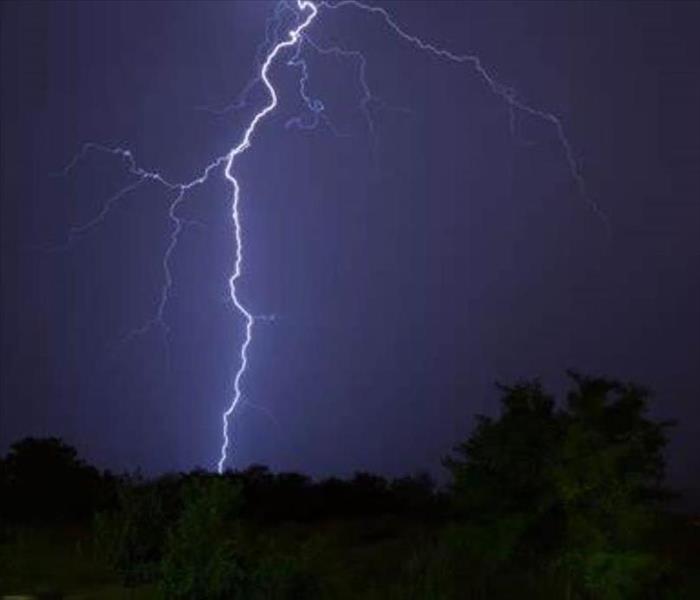
Lightning Risks and Safety Tips Lightning causes thunder, so if you hear thunder, there is lightning nearby. And since lightning can strike as far as 10 miles from a thunderstorm, it is important to try and figure out how far lightning is far you and your family, instead of simply waiting for it to start raining until you seek shelter.
How do you figure out how far the lightning is? A general rule of thumb is that you can figure out the distance between you and a lightning strike if you count the seconds in between seeing a lightning strike, hearing thunder, and then divide the time by 5. So if you count 10 seconds in between a lightning strike and a thunderclap, then the lightning is only about 2 miles away and you should seek shelter in a car or building.
In general, you should make sure that you can count to at least 30 in between seeing lightning strikes and hearing thunder, which means that the lightning is about 6 miles away. And to be safe, stay indoors for at least 30 minutes after hearing thunder for the last time, which should give the thunderstorm plenty of time to move out of your area.
Other tips to keep safe when lightning is nearby include:
- Seek shelter inside a fully enclosed building that has wiring or plumbing, which would usually not include a shed, open garage, or pavilion.
- Seek shelter in a hard-topped car, truck, or van, etc., if a safe building is not available
- If you can't get inside a safe building or vehicle, seek shelter in a low-lying area that is not prone to flash flooding, squatting low to the ground, and stay away from tall trees or metal poles.
- Avoid riding on anything metal during a severe thunderstorm with close lightning, such as a bicycle or golf cart.
- Stay off corded phones and avoid taking a bath or shower, as telephone lines and metal pipes can conduct electricity if your home is struck by lightning.
- Seek emergency medical attention to you see someone hit by lightning and start first aid, including CPR if necessary.
Although there are now apps on smartphones, like WeatherBug's Spark that can warn you when lightning is near, just remember the old safety slogan, "When thunder roars, go indoors!"
How To Prevent Flooding In Your Home
3/11/2020 (Permalink)
We all know what your home could look like after a flood or during heavy rainfall. A homeowner can lose precious belongings, and sometimes family members and pets can be at risk since events such as these are usually unexpected. Being prepared will help you and your loved ones to remain safe.
With that in mind, here some tips to help you prevent flooding in your home:
- INSPECTION. Take a good look around your house to ensure that you are prepared for wet weather. Check exterior doors to see if they fit as tightly as they should and that both doors and windows are properly weather-stripped. A small leak can easily turn into a small flood. Your driveway needs to have a well-planned drainage system so entering and exiting your home can be safe even during wet weather. If you know you’ll see a lot of run-off from the street or yard, or perhaps bodies of water in your neighborhood, you should consider using sandbags. Homes and low-lying buildings near a flooding body of water can end up being at risk, so you will want to plan ahead to prevent that from happening.
- COMMUNICATE WITH PUBLIC SERVICES. Drainage areas that are maintained by the city or county are monitored, especially during heavy rains. If these spots begin to overflow, make sure to contact your city representatives immediately to keep them informed and updated. If there is a problem developing, you can take steps to sandbag vulnerable areas around your home and buildings on your property.
- INTERIORS. Some flooding isn’t caused by weather; it’s caused by an equipment failure. Make sure your plumbing and appliances are regularly inspected and maintained so that you don’t experience this kind of flooding. Take a look at basements and garages regularly so that you can stay on top of things. It’s all about preparedness.
The team here at SERVPRO of Greenwood, Abbeville & McCormick Counties is always ready to help in any way we can. We have the expertise to handle water and fire damage, and we specialize in mold remediation. If you have sustained water damage to your property, give us a call today!
When Storms or Floods hit Greenwood, Abbeville, & McCormick, SERVPRO is ready!
9/12/2017 (Permalink)
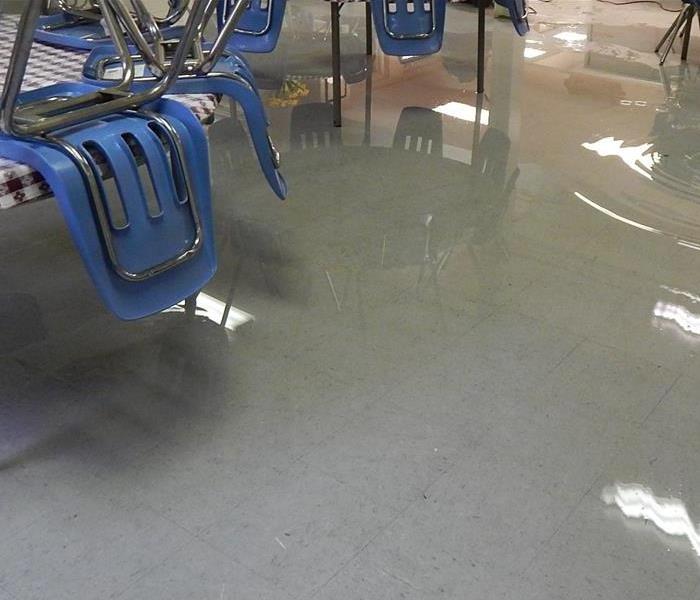 Our highly trained crews are ready to respond 24/7 to storm or flood damage in Greenwood, Abbeville, & McCormick.
Our highly trained crews are ready to respond 24/7 to storm or flood damage in Greenwood, Abbeville, & McCormick.
SERVPRO of Greenwood, Abbeville, & McCormick specializes in storm and flood damage restoration. Our crews are highly trained and we use specialized equipment to restore your property to its pre-storm condition.
Faster Response
Since we are locally owned and operated, we are able to respond quicker with the right resources, which is extremely important. A fast response lessens the damage, limits further damage, and reduces the restoration cost.
Resources to Handle Floods and Storms
When storms hit Greenwood, Abbeville, & McCormick, we can scale our resources to handle a large storm or flooding disaster. We can access equipment and personnel from a network of 1,650 Franchises across the country and elite Disaster Recovery Teams that are strategically located throughout the United States.
Have Storm or Flood Damage? Call us today 864-229-6610



 24/7 Emergency Service
24/7 Emergency Service

